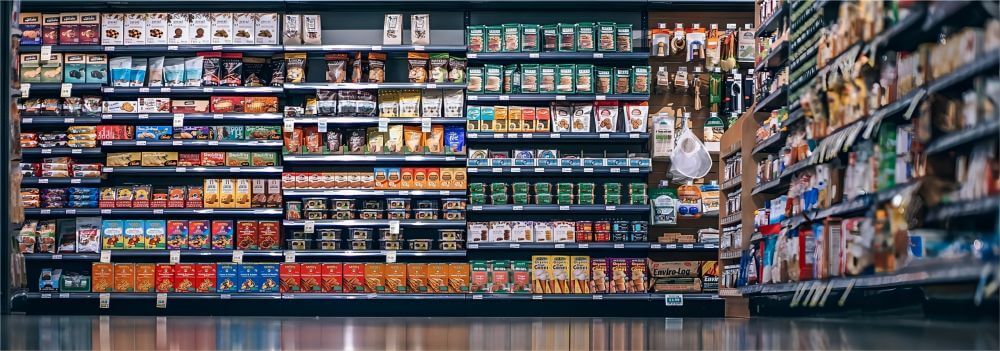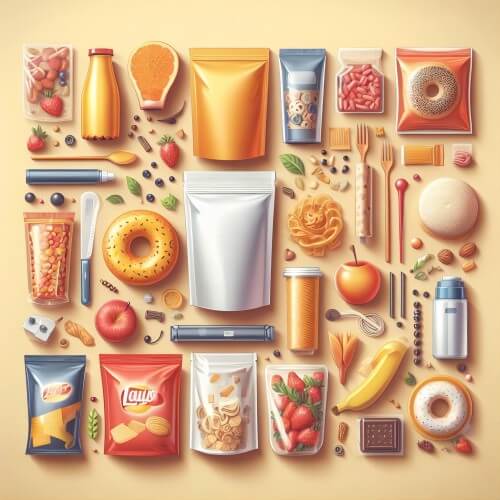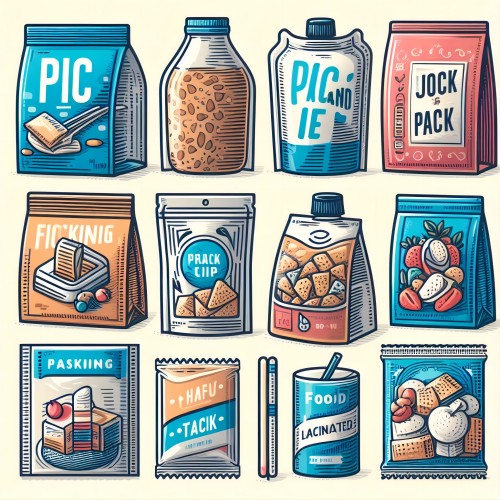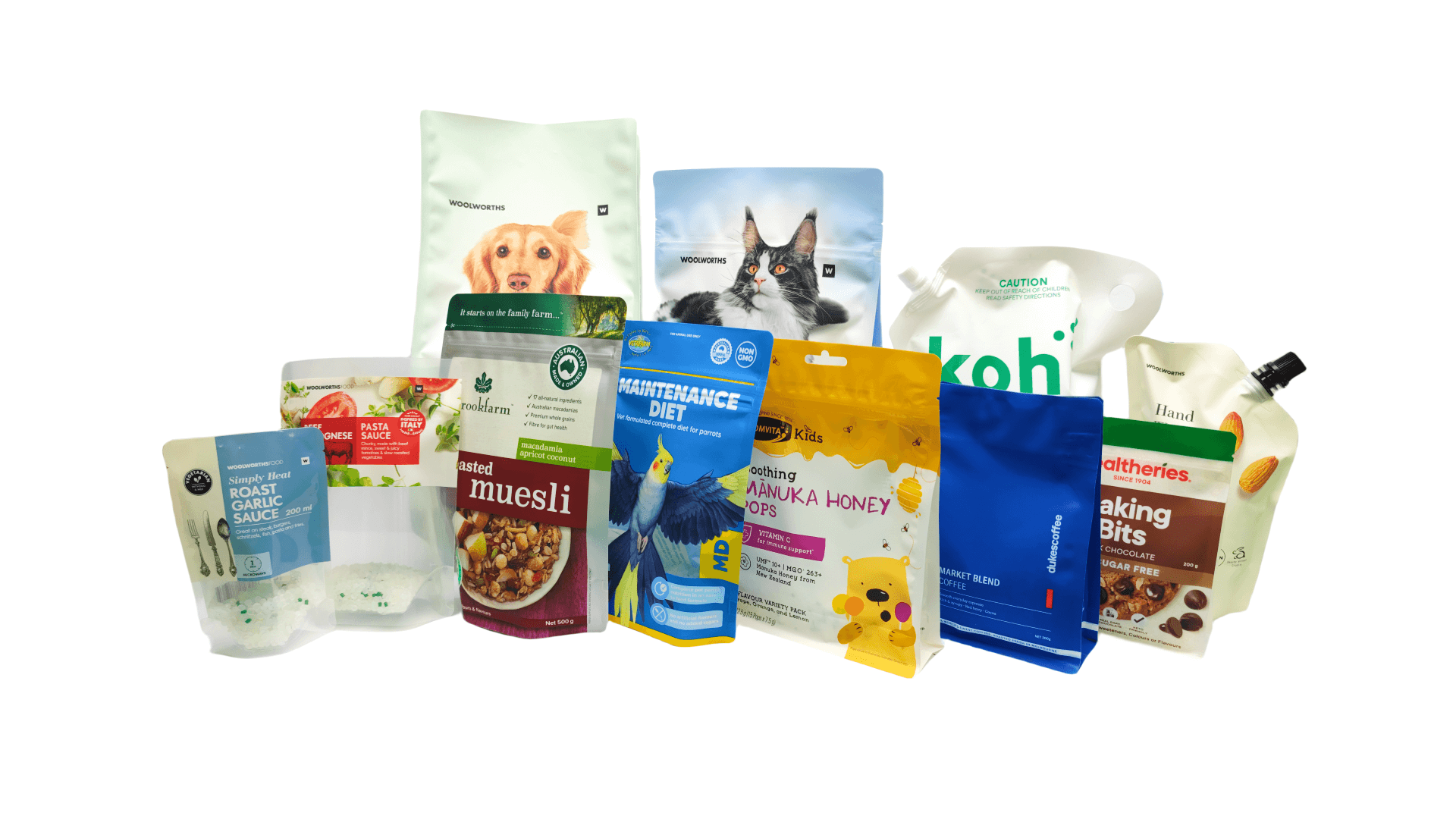5 Different Types of Flexible Food Packaging Designs
What is Flexible Food Packaging?
Food packaging is a system specifically designed for food, protecting from chemical, biological, and physical alterations. It aims to deliver food goods at a reasonable cost while meeting the needs of both consumers and industries. It has evolved with technological advancements and is crucial in preserving food during transport, storage, and retail sales.
Food packaging serves various functions, including containment, communication, and protection. It comes in different types such as bags, bottles, cans, cartons, and trays, and is labeled with information such as ingredients, nutritional content, and shelf life.
Flexible food packaging, a popular type of food packaging, uses non-rigid materials such as paper, plastic, film, and aluminum foil to provide economical and customizable options. These materials are chosen based on the specific requirements of the food product, such as its sensitivity to light, oxygen, or moisture. It includes bags, pouches, liners, wraps, and roll stock, depending on the application and the type of food being packaged. Flexible food packaging is particularly useful in industries that require versatile packaging, such as the food and beverage industry.
Advantages of Flexible Food Packaging
Flexible food packaging offers several advantages that make it a popular choice for packaging food products.
The benefits include versatility, convenience and mobility, enhanced product life, branding and marketing opportunities, user-friendly packaging, cost-effectiveness, and sustainability. It also requires less energy than rigid packaging and can be designed for reuse and recyclability, making it environmentally friendly.
Versatility
Flexible food packaging can be easily customized and adapted to various shapes, sizes, and food products.
It allows for different packaging formats such as pouches, bags, sachets, and wraps, making it suitable for a wide range of food items, from snacks and beverages to frozen foods and pet food.
Convenience and Mobility
Flexible packages are lightweight and mobile, offering practicality and convenience for consumers, allowing them to take the product anywhere.
The lightweight for flexible food packaging is generally compared to rigid packaging alternatives such as glass or metal containers. This lightweight nature reduces transportation costs and energy consumption.
Additionally, flexible packaging takes up less space both during transportation and on store shelves, allowing for efficient storage and display.
Enhanced product life
Flexible packaging retains the freshness of food products, provides excellent barrier properties, protecting food products from moisture, oxygen, light, and contaminants.
This helps to extend the shelf life of perishable foods by preventing spoilage, preserving freshness, and maintaining quality. The barrier properties can be customized based on the specific requirements of the food product.
Branding and Marketing Opportunities
Flexible packaging provides ample space for branding, product information, enabling variable colors and attractive designs. It offers opportunities for eye-catching graphics, logos, and product descriptions, helping to enhance brand visibility and attract consumers. The printing capabilities on flexible packaging allow for vibrant colors and high-quality imagery.
All enhance the package and incorporate innovative technologies such as invisible QR codes.
Cost-effectiveness
Flexible food packaging is often more cost-effective than rigid packaging options. It requires fewer materials, occupies less storage space, and reduces transportation costs due to its lightweight nature.
The efficiency in production, storage, and transportation can help lower overall packaging costs.
User-friendly
Flexible packaging is attractive, practical, and convenient for consumers, as it extends shelf life, is easy to store, is microwavable, and can be reclosed.
Sustainability
Many flexible food packaging materials are lightweight, which translates to reduced material usage and lower carbon footprint during transportation.
Additionally, advancements have been made in developing recyclable and compostable flexible packaging materials, contributing to sustainability efforts and reducing environmental impact. These materials can help divert waste from landfills and promote a circular economy.
Applications of Flexible Food Packaging
Flexible packaging finds wide-ranging applications in the food industry.
| Dry Goods and Snacks | Flexible packaging is suitable for packaging nuts, dried fruits, and snack products. It helps maintain freshness and crispness while providing easy-to-use and resealable features |
| Frozen Foods | Flexible packaging is extensively used in the frozen food sector. It offers excellent resistance to moisture and freezing effects, effectively preventing freezer burn and changes in product quality |
| Beverages and Liquid Foods | Flexible packaging can incorporate designs with nozzles or straws, allowing consumers to drink beverages and liquid foods directly from the packaging. This packaging form also helps maintain the freshness and taste of beverages |
| Kitchen Seasonings and Sauces | Many kitchen seasonings and sauces opt for flexible packaging because it allows for convenient flow control through special nozzles or pours spouts, reducing waste and contamination |
The appropriate flexible food packaging type can be chosen based on different food requirements and desired display effects.
When selecting flexible packaging for food products, there are several key considerations that will guide the optimal packaging choice to meet product needs:
Rather than a one-size-fits-all approach, the flexible food packaging type should align with the specific food item’s properties, intended use case, required shelf life, and desired consumer experience. Key aspects for alignment include target formats such as pouches, bags or wraps; barrier properties to appropriately preserve freshness; managing food contact and migration risks; and optimizing format and design for envisioned storage, stocking and usage.
Additionally, factors like envisioned placement in retail environments, branding and communication goals, and conveying product qualities through packaging shape, appearance and functionality play a role. The packaging style can be tailored to enable the ideal product presentation and experience across the supply chain – from transportation and stocking by retailers all the way to home use by consumers. By thoughtfully aligning these packaging considerations to each food product’s priorities, the optimal materials and packaging format can be selected.
Flexible Packaging Designs for Food
Flexible packaging for food encompasses a wide range of packaging formats and materials. The flexible food packaging should ensure the packaging meets functional, aesthetic, and regulatory requirements.
Some common types of flexible packaging used for food like pouches, bags, films/wraps, sachets/stick packs, and laminated structures…
| Pouches |
|
| Bags |
|
| Films/Wraps |
|
| Sachets/Stick Packs |
|
| Laminated Structures |
|
Pouch Packaging Designs for Food
Pouch packaging is a popular and versatile option for food products. There are some common pouch designs for food.
| Stand Up Pouches |
|
| Spouted Pouches |
|
| Flat Pouches |
|
| Side Gusset Pouches |
|
| Quad Seal Pouches |
|
| Shaped Pouches |
|
| Retort Pouches |
|
| Frozen Pouches |
|
| Doypack Pouches |
|
When designing pouch packaging for food, consider factors such as the product’s characteristics, shelf life requirements, convenience features, branding opportunities, and regulatory compliance. Collaborate with packaging suppliers and manufacturers to ensure the design aligns with production capabilities and meets quality standards.
The Sustainable Contribution of Flexible Food Packaging
Flexible packaging plays a vital role in sustainable development.
Resource Efficiency
With reduced material consumption, flexible packaging contributes to resource conservation. Additionally, the lightweight nature and optimized design of flexible packaging result in lower energy consumption and carbon emissions during transportation.
Recyclability
Many flexible packaging materials can be recycled and reused, reducing waste generation. Packaging manufacturers are continuously exploring innovative solutions using biodegradable and recyclable materials.
Carbon Footprint
The lightweight and optimized design of flexible packaging minimizes energy consumption and carbon emissions during transportation. This helps reduce the impact of climate change and lower carbon footprints.
Environmental Protection
Flexible packaging provides effective protection and barriers, reducing food waste and pollution. It extends the shelf life of food products, reducing the quantity of expired or damaged food.
Flexible food packaging, with its lightweight, versatile, and sustainable advantages, is revolutionizing the food industry. Its applications range from dry goods and snacks to frozen foods, beverages, and kitchen seasonings. By improving resource efficiency, recyclability, and reducing carbon footprints, flexible packaging contributes to sustainable development. Looking ahead, we anticipate more innovative solutions in flexible packaging to meet evolving food packaging needs while promoting environmental protection and sustainability.
Start With KDW
+86 13559233681(Wechat, Whatsapp)
No1, Anbian Rd, Torch High-Tech Zone (XiangAn), Xiamen, Fujian, China





